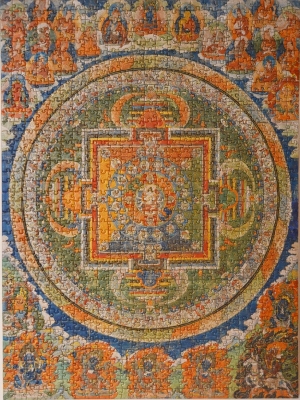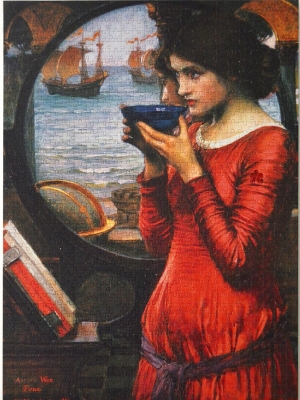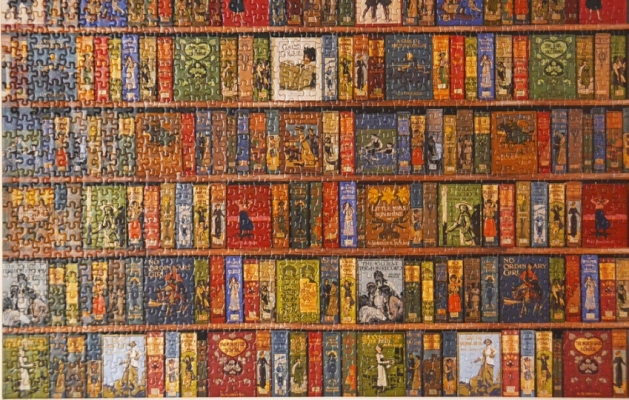Jigsawitis or My Road to Addiction
Actually, it all began quite innocently. Me and myself circa 2019 BC (Before Corona) had unexpectedly received a present of a jigsaw puzzle that on closer inspection contained 1,000 pieces. After having previously honed my skills with our grandchildren and having helped them to assemble puzzles with roughly 50 to 100 pieces, I was undaunted and felt confident to tackle one on a larger scale.
After a lengthy and eventually satisfactory completion of this first project and after admiring my handiwork, the first withdrawal symptoms began to appear. My fingers began to itch and life felt somehow empty. Entering bookshops, ignoring all that boring printed stuff, I would gaze longingly at all the jigsaw puzzles on display and at home I would trawl the email book sites admiring the tempting variety for sale. A temporary fix was attained by purchasing a beautiful scene of rural Holland, sitting down and finally fitting in the last piece. Alas, I had simply whetted my appetite and very soon the same symptoms recurred.
Oscar Wilde reputedly said: "I can resist everything except temptation." This truism applied to me and with the passage of time, I had succumbed and ordered puzzles from overseas. Happily clutching the boxes, I returned home and after lengthy deliberation chose the first one to start.
Now, there are definite stages in the addict's progress. After having opened the box, and spilling a generous pile of multi-colored cardboard pieces out on a suitable surface, begins the boring and onerous task of turning them over and sorting out into those with straight edged borders and those of different colors. Beware of faltering and banish all extraneous thoughts such as: "Here am I wasting my precious time while I could be helping humanity by discovering new lifesaving medications!" or even worse: "What about all those urgent household repairs waiting for me." Just carry on regardless and your patience and diligence shall be rewarded as the puzzle begins to take shape. As your project finally nears completion and the pile of pieces begins to diminish, ignore any nagging doubts that there will be a few missing – this phenomenon is quite common and completely unfounded and soon you will be gazing in admiration at your completed masterpiece.
A few tips for the neophyte. Begin with an easier subject that has many straight lines and clearly defined colors such as a collection of doors or bookends. Rural scenes with much shrubbery and flowers, whilst being most beautiful, have many shades of colors that mingle and demand much more patience and time. Limit yourself to a 1,000 piece maximum. This is sufficiently challenging and the size is not unwieldy.
Where to obtain them? There is no lack of choice since many hobby shops and stationery chains offer a wide variety and the only limitation is your time, space and the depth of your pocket: for the serious junkies, 9,000 pieces and beyond are also available. I personally buy from a well-known online English book site offering a great range with reasonable prices.
Always choose a workplace that is amenable to the whole family, as you do not wish to gain their lasting enmity by annexing the dining room table for weeks on end and so forcing unappreciative kin and guests to crowd into the kitchen. As our fledglings have long fled the nest, I have laid two large cardboard placards – easily obtainable from stationery and craft shops – on a bed in the spare room with one devoted to the pieces and the other to the completed work. Moreover, as a 1000 piece puzzle generally measures 50 x 70 centimeters, you now have lots of space and can work undisturbed. A word of warning: on no account let unwanted intruders try their hand at helping you as this is the easiest way to lose precious pieces.
Feeling temporarily overwhelmed? Avoid frustration. Go to the internet where you can find sites giving helpful advice and encouragement. Patience is a virtue. Do not attempt hour long marathons, just set aside and continue later. When refreshed, your concentration is infinitely better and thou shalt be amply rewarded.
Once your masterpiece has been completed, you are justly entitled to share your joy with others by press ganging reluctant spouses, family, friends, neighbours and passing acquaintances into the room to admire your handiwork and hear their mumbled encomiums. Or you can go even further (as I did) by permanently mounting it for posterity. Another trip to the arts and craft shops procures a 100 by 70 cm, 1cm thick white foam filled board ("kappa" in Hebrew). After cutting out the correct measurement, you brush plastic glue over the board, carefully slide the puzzle onto it and let dry. This operation requires skill and patience as mistakes are extremely difficult to correct. I have done this a few times and the finished articles are now adorning our humble abode's walls.
"Fine", you may well ask, "But are there any benefits to be gained from this time-consuming pastime?" My answer would definitely be in the positive. Not everyone (including me – a low brow) goes for cards or is a Bridge enthusiast. Attempting a jigsaw focuses the mind and hones both visual and cognitive skills – the more you complete, the more adept you become.
A puzzle can not only be an aesthetic pleasure but also serve as a pathway to acquiring and enriching knowledge. Completing 'The Garden of Earthly Delights', the central panel of an intriguing triptych by Hieronymus Bosch, led into researching not only the fascinating painting but also the painter and his era. A portrait by a pre-Raphaelite painter renewed my acquaintance with that school and became a stimulus to reread some of their poets, whom I had not touched since university days, whilst a striking Tibetan mandala with a goddess at its center surrounded by deities and demons aroused my curiosity for a brief delving into Buddhist mythology. A puzzle of rows of girls' books from the early 20th century on the shelves of the Bodleian Library was both aesthetically pleasing and provided a delightful insight into the social mores of that period. A beautiful puzzle of a daimyo's palace at Osaka was not only a delight to the eye but also a perfect complement to my interest in Japanese history.
Happily, there is no age limit as jigsaws appeal to the child in us all. Moreover, puzzle completing needn't be a solo activity and if so wished can be done with a partner and/or include family members: a rainy weekend indoors is an ideal time for starting. So with winter on our threshold, now is the ideal time to get started. Which reminds me – the box with a Klimt portrait is beckoning to be opened!












Comments